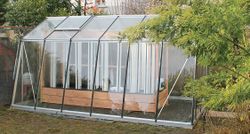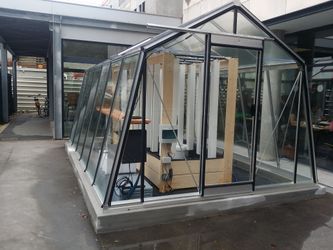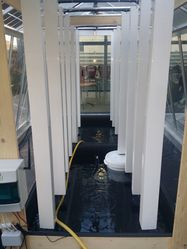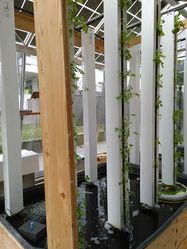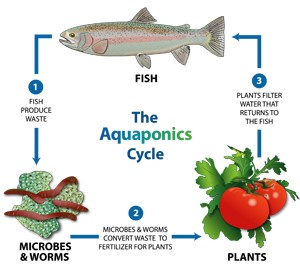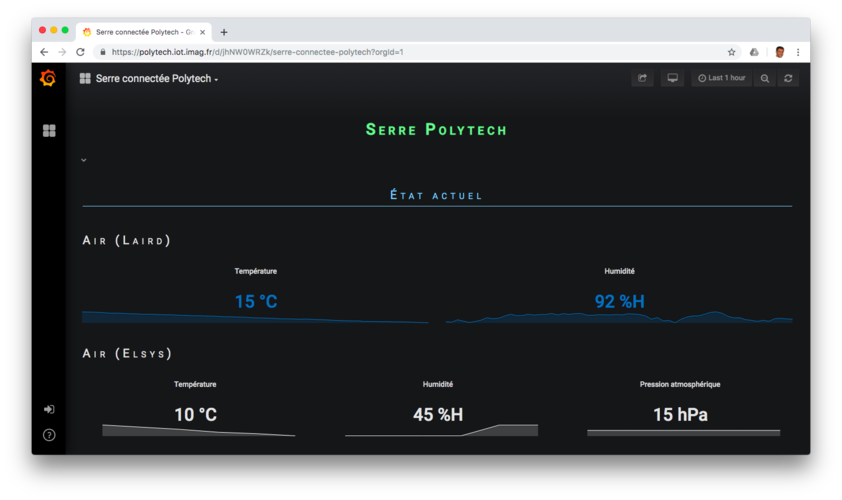Difference between revisions of "ASAC/AP"
| (34 intermediate revisions by 4 users not shown) | |||
| Line 1: | Line 1: | ||
| − | = Général présentation = |
||
| + | This project is part of the [[ASAC]] project. |
||
| − | We are a group of 8 engineering students from Polytech Grenoble and we have as a project to install a partially autonomous greenhouse with an aquaponic system inside the university during the year of 2017-2018. The other part will be taken care by the humanitarian club of the university. |
||
| + | = Introduction = |
||
| − | [[File:serre aquaponie.jpg]] |
||
| + | An aquaponic greenhouse is available for projects made by engineering students from Polytech Grenoble [https://www.polytech-grenoble.fr/]. |
||
| − | One part of the project has already been done last year but in a different way. The students of the RICM (Computer Network and Multimedia Communication) of our school had to take care of the instrumentation of the greenhouse. This year, the goal of our group is also to use various sensors, which will verify some intern parameters in the greenhouse, like air temperature and water temperature, humidity rate or even the pH of the water tank. We also have as objective to develop and build an automatic food distributor for the fishes living in the tanks, which will enable us to be absent for some time without concerning about their alimentation. |
||
| + | The greenhouse is also managed by the humanitarian club of the university. |
||
| + | [[File:serre aquaponie.jpg|250px|thumb|Greenhouse exemple]] |
||
| + | |||
| + | The projects involve students from the RICM/INFO (Computer Network and Multimedia Communication) department, the IESE (Computer Science and Electronics for Embedded Systems) department, and the MAT (Materials) department. The overall goal is also to deploy and configure various sensors, which will verify some intern parameters in the greenhouse, like air temperature and water temperature, humidity rate, or the pH of the water tank in a user friendly environment. To use the exploitation of the greenhouse, some student projects are dedicated to enhance the surrounding environment of the greenhouse with an automatic food distributor, some water tank for rain water, embellish/secure the floor or build some wicking beds. |
||
| + | |||
| + | {|style="margin: 0 auto;" |
||
| + | | [[File:Greenhouse-Polytech-outside.jpg|x250px|thumb|Greenhouse@Polytech viewed from outside]] |
||
| + | | [[File:Greenhouse-polytech-inside.jpg|x250px|thumb|Greenhouse@Polytech viewed from inside]] |
||
| + | | [[File:Plantes-polytech-2019-03.jpg|x250px|thumb|Greenhouse@Polytech with plants (March 2019)]] |
||
| + | |} |
||
= What is aquaponics ? = |
= What is aquaponics ? = |
||
| Line 18: | Line 27: | ||
* The plants filter the aquarium water by assimilating the minerals with their roots. In this way, the nutriments in mineral form can feed the vegetal. |
* The plants filter the aquarium water by assimilating the minerals with their roots. In this way, the nutriments in mineral form can feed the vegetal. |
||
In this system that we are going to set up, a water pump, powered by solar panels, will be used to transport the water with fish waste to the plants. |
In this system that we are going to set up, a water pump, powered by solar panels, will be used to transport the water with fish waste to the plants. |
||
| + | |||
= What is the objective of aquaponics ? = |
= What is the objective of aquaponics ? = |
||
| Line 25: | Line 35: | ||
In long term, this type of culture can be conceivable in large scale to overcome the problems of future food production and soil impoverishment. |
In long term, this type of culture can be conceivable in large scale to overcome the problems of future food production and soil impoverishment. |
||
| − | = The Team = |
||
| − | == Teachers == |
||
| − | |||
| − | The teacher leading the project is Nicolas PALIX.(http://lig-membres.imag.fr/palix/) |
||
| − | He can be helped by Benoit MARCHANT and Vincent HIBON. |
||
| − | |||
| − | == Student Team == |
||
| − | |||
| − | Our team is formed by 2 fields of study from Polytech Grenoble. The first one, Materials, trains general science and material engineers who are able to understand all the materials present in our environment like polymers, metals, ceramics and composites. |
||
| − | The second field, Computing and Electronics Embedded Systems, trains engineers with a triple expertise in automatic, electronic and industrial data processing. Systems integrators, the graduated in IESE department are to design, implement and describe a group of electronics and complex data processing like measuring channels, automation of the production processes and even embedded systems. |
||
| − | [[File:photo de groupe.jpg|280px|thumb|student team picture]] |
||
| − | |||
| − | {|class="wikitable" |
||
| − | !scope="col"| Name |
||
| − | !scope="col"| study class |
||
| − | |- |
||
| − | !scope="row"| Faustine MICHEL |
||
| − | | IESE-3 |
||
| − | |- |
||
| − | !scope="row"| Bastien BONTE |
||
| − | | IESE-3 |
||
| − | |- |
||
| − | !scope="row"| Paulo NAVES |
||
| − | | IESE-4 |
||
| − | |- |
||
| − | !scope="row"| Erik NAYAN |
||
| − | | IESE-4 |
||
| − | |- |
||
| − | !scope="row"| Antoine RONCO |
||
| − | | MAT-3 |
||
| − | |- |
||
| − | !scope="row"| Dorian REBOULLET |
||
| − | | MAT-3 |
||
| − | |- |
||
| − | !scope="row"| Eglantine LEJEUNE |
||
| − | | MAT-4 |
||
| − | |- |
||
| − | !scope="row"| Apolline LIMOUSIN |
||
| − | | MAT-4 |
||
| − | |- |
||
| − | |} |
||
| − | |||
| − | = Project Devices = |
||
| − | |||
| − | == The food distributor == |
||
| − | |||
| − | [[File:exemple distributeur.jpg|100px|thumb|distributor exemple]] |
||
| − | |||
| − | In order to feed all the fishes without having any human intervention during a long period, we are going to use a food dispenser who will be responsible for delivering a portion of food to the fishes every single day. This dispenser needs to be able of being charged with an sufficient amount of food to feed the fishes for at least one week. |
||
| − | |||
| − | Knowing there are many types of fish food, it's needed to choose an adapted dispenser according to the type of food we are going to give to the fishes. The fishes can be nourished with food in flakes, granulated food or raw meat. The granulated nourishment seems to us the most suitable solution, as the flakes could get stuck together due to a possible humidity exposure, considering that the dispenser is inside the greenhouse and potentially on the tank. Concerning the raw meat, it would be necessary to have a refrigeration system to conserve it. |
||
| − | Several paths are emerging for the design of this dispenser: either a classic dispenser in a round shape with previously dimensioned food portions, or a tube-shaped dispenser inspired by a conventional cereal dispenser where the crank delivering the food would be automated by an attached motor. |
||
| − | |||
| − | There are also several issues to consider besides the type of food, including how food is dispersed. Indeed, it is possible that the fish may fight if the distribution is done in a limited zone of the basin. To avoid having this problem, we will try in a second time to design a ramp to have multiple impact zones in the basins. |
||
| − | To develop this dispenser we will firstly draw the distributor in 3D on a computer with 3D drawing software (AutoCAD), then we will use the available infrastructure at Fablab in Grenoble to perform a 3D printing of our dispenser. |
||
| − | |||
| − | == Sensors device == |
||
| − | |||
| − | In order to facilitate the control and maintenance of the culture in Aquaponics we will use a couple of different sensors. The distinct data collected by the sensors allow us to control the quality of life in the greenhouse. The water in the fish pond must be suitable for their body, the temperature of the greenhouse must be adapted as well as the humidity. Therefore, we will use the following sensors: |
||
| − | |||
| − | === Water temperature sensor === |
||
| − | |||
| − | This sensor will make it possible to indicate the temperature of our tank in order to be able to act on it so that the fishes can live in good conditions. |
||
| − | [[(https://www.adafruit.com/product/381)]] |
||
| − | |||
| − | === Temperature and humidity sensor === |
||
| − | |||
| − | For the plant cultivation to grow in good conditions, the humidity and the temperature must be optimal. The temperature and humidity sensors will allow us to better regulate the conditions of the greenhouse, by opening the windows and by controlling a ventilation system. |
||
| − | (BMP180, DHT11) |
||
| − | |||
| − | === Water level sensor === |
||
| − | |||
| − | The water level sensor will be used to check the amount of water in the tanks where the fish are. We will be informed whether or not to add water to the basins. It will be necessary to design a protection around the sensor to avoid that it is in contact with the fishes or to protect the wires from the water. |
||
| + | = Dashboard = |
||
| − | === PH sensor === |
||
| + | [[Image:polytech.iot.imag.fr.png|thumb|https://polytech.iot.imag.fr/]] |
||
| − | The pH sensor will allow us to ensure a good quality of water in our basins. The water should ideally remain neutral (PH = 7) to ensure a good living condition for the fishes. |
||
| − | = LoRa Technology = |
||
| + | [[Image:Grafana-polytech.png|x500px|Grafana]] |
||
| − | Once the data is taken by the sensors and processed by the SRM32 board, it is necessary to send them to a computer which will enable us to monitor the information without being in the greenhouse. We will use the technology LoRa from a Grenoble startup Cycleo purchased by Semtech. |
||
| + | = The Teams = |
||
| − | [[File:STM32 Nucleo board and expansion board LoRa.jpg]] |
||
| + | * [[ASAC/AP/AP-2017]] |
||
| − | The STM32 Nucleo board (below) and the expansion board LoRa (above) |
||
| + | * [[ASAC/AP/AP-2018]] |
||
| + | * [[ASAC/AP/AP-2019]] [https://gricad-gitlab.univ-grenoble-alpes.fr/Projets-INFO4/19-20/3/docs/-/blob/master/README.md ASAC/AP/AP-2019-INFO] |
||
| + | * [[ASAC/AP/AP-2020-CO]] [[ASAC/AP/AP-2020-INFO]] |
||
| + | = Source code repository = |
||
| − | LoRa is based on the LoRaWAN protocol that allows you to communicate at low speed, by radio. It is possible to transmit data over a maximum distance of about 20 km. But we must take into account that we can not transmit data such as videos, so it is perfect for our project since we will send only sensor data. Another advantage of this technology is the very low power consumption and its small size. |
||
| + | https://gricad-gitlab.univ-grenoble-alpes.fr/ASAC/serre-polytech |
||
| − | = Conclusion = |
||
| + | * https://gricad-gitlab.univ-grenoble-alpes.fr/Projets-INFO4/19-20/3 |
||
| + | * https://gricad-gitlab.univ-grenoble-alpes.fr/Projets-INFO4/18-19/4 |
||
| + | = Internet Links = |
||
| − | This collective project is ambitious and innovative. As future engineers, we have to create a dynamic and strict group in our work. Teamwork is an advantage which enable us to advance efficiently in this project. Moreover, we will do our best to bring together our personal and engineering knowledge to enhance our work. |
||
| + | https://www.polytech-grenoble.fr/ |
||
| − | Furthermore, the students of Computer Network and Multimedia Communication will join us in this project to improve the storage and the sharing of the data. They will create an application which will allow us to know the data of the greenhouse anywhere and even save the data measured by the sensors. |
||
| + | https://myfood.eu/ |
||
| − | The aquaponics is in development around the world, and can provoke the attention of big companies in the horticulture sector. Moreover, this way of culture could be adapted for a domestic application |
||
Latest revision as of 17:47, 18 January 2021
This project is part of the ASAC project.
Introduction
An aquaponic greenhouse is available for projects made by engineering students from Polytech Grenoble [1]. The greenhouse is also managed by the humanitarian club of the university.
The projects involve students from the RICM/INFO (Computer Network and Multimedia Communication) department, the IESE (Computer Science and Electronics for Embedded Systems) department, and the MAT (Materials) department. The overall goal is also to deploy and configure various sensors, which will verify some intern parameters in the greenhouse, like air temperature and water temperature, humidity rate, or the pH of the water tank in a user friendly environment. To use the exploitation of the greenhouse, some student projects are dedicated to enhance the surrounding environment of the greenhouse with an automatic food distributor, some water tank for rain water, embellish/secure the floor or build some wicking beds.
What is aquaponics ?
The term “aquaponics” comes from the link between the words aquaculture, fish or other aquatic organism farming, and hydroponic, culture of plants by the use of water rich in minerals. Therefore, aquaponics is plants and fish farming in symbioses. This type of culture was firstly used by Aztecs and Chinese. Thus, we can assimilate aquaponics to an ecosystem where 3 types of organisms live in an ecologic cycle:
- The fishes produce waste that will be used as nutriments for the plants. This waste is rich in nitrogen (ammonium and urea), in phosphor and in potassium. Elements that are essential for the plants.
- Bacterias transform the organic material, like ammonium and urea, in nitrites and then nitrates. The nitrates are in mineral form and the plants are able to use them as food.
- The plants filter the aquarium water by assimilating the minerals with their roots. In this way, the nutriments in mineral form can feed the vegetal.
In this system that we are going to set up, a water pump, powered by solar panels, will be used to transport the water with fish waste to the plants.
What is the objective of aquaponics ?
Aquaponics can have different objectives depending on the desire. It can be alimentary, like vegetables and fish farming, but also for hobby or even educational. The main issue is to find the balance between the fish population, the food to feed them, the bacterial population and the plants farmed: an anomaly in any of these parameters can destroy the ecosystem. In long term, this type of culture can be conceivable in large scale to overcome the problems of future food production and soil impoverishment.
Dashboard
The Teams
- ASAC/AP/AP-2017
- ASAC/AP/AP-2018
- ASAC/AP/AP-2019 ASAC/AP/AP-2019-INFO
- ASAC/AP/AP-2020-CO ASAC/AP/AP-2020-INFO
Source code repository
https://gricad-gitlab.univ-grenoble-alpes.fr/ASAC/serre-polytech
- https://gricad-gitlab.univ-grenoble-alpes.fr/Projets-INFO4/19-20/3
- https://gricad-gitlab.univ-grenoble-alpes.fr/Projets-INFO4/18-19/4
